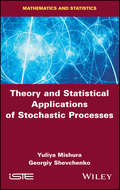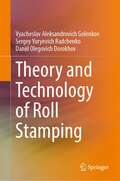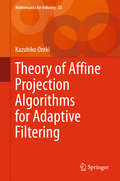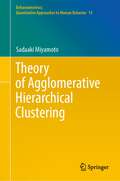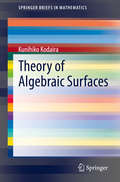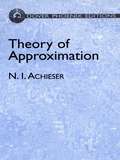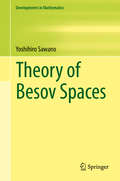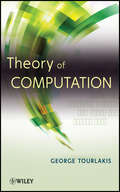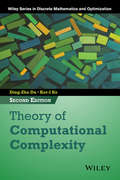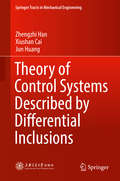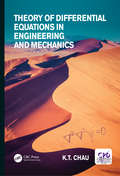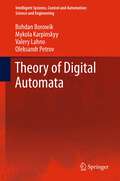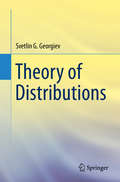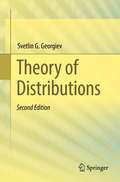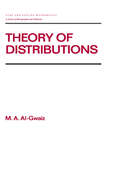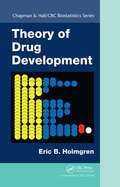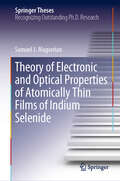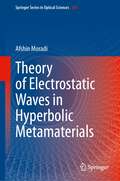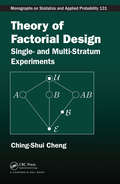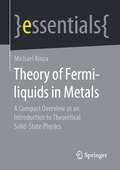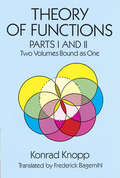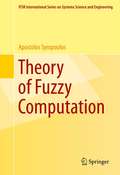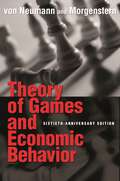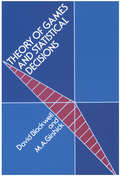- Table View
- List View
Theory and Statistical Applications of Stochastic Processes
by Yuliya Mishura Georgiy ShevchenkoThis book is concerned with the theory of stochastic processes and the theoretical aspects of statistics for stochastic processes. It combines classic topics such as construction of stochastic processes, associated filtrations, processes with independent increments, Gaussian processes, martingales, Markov properties, continuity and related properties of trajectories with contemporary subjects: integration with respect to Gaussian processes, Itȏ integration, stochastic analysis, stochastic differential equations, fractional Brownian motion and parameter estimation in diffusion models.
Theory and Synthesis of Linear Passive Time-Invariant Networks
by Dante C. YoulaExploring the overlap of mathematics and engineering network synthesis, this book presents a rigorous treatment of the key principles underpinning linear lumped passive time-invariant networks. Based around a series of lectures given by the author, this thoughtfully written book draws on his wide experience in the field, carefully revealing the essential mathematical structure of network synthesis problems. Topics covered include passive n-ports, broadband matching, the design of passive multiplexes and two-state passive devices. It also includes material not usually found in existing texts, such as the theoretical behavior of transverse electromagnetic (TEM) coupled transmission lines. Introducing fundamental principles in a formal theorem-proof style, illustrated by worked examples, this book is an invaluable resource for graduate students studying linear networks and circuit design, academic researchers, and professional circuit engineers.
Theory and Technology of Roll Stamping
by Vyacheslav Aleksandrovich Golenkov Sergey Yuryevich Radchenko Daniil Olegovich DorokhovThis book gives a complete overview of the roll stamping process of metal forming. This fundamentally new technique features an integrated local loading of the plastic deformation zone of the workpiece, simultaneously combining the die forging operation and local deformation of the deformation zone by rotating rollers or drive rolls. The book presents the basics of the theory behind roll stamping, delivering a complete technical analysis including the key results of mathematical modeling studies and a discussion of methodologies for designing novel roll stamping techniques. The aim of the new metal forming processes proposed in the book is directed toward the production of competitive equipment for fabrication of various mechanical parts having enhanced materials and physical properties in combination with a low cost of production and maintenance. This book is an ideal resource for any student or practicing engineer working with the roll stamping process.
Theory of Affine Projection Algorithms for Adaptive Filtering
by Kazuhiko OzekiThis book focuses on theoretical aspects of the affine projection algorithm (APA) for adaptive filtering. The APA is a natural generalization of the classical, normalized least-mean-squares (NLMS) algorithm. The book first explains how the APA evolved from the NLMS algorithm, where an affine projection view is emphasized. By looking at those adaptation algorithms from such a geometrical point of view, we can find many of the important properties of the APA, e. g. , the improvement of the convergence rate over the NLMS algorithm especially for correlated input signals. After the birth of the APA in the mid-1980s, similar algorithms were put forward by other researchers independently from different perspectives. This book shows that they are variants of the APA, forming a family of APAs. Then it surveys research on the convergence behavior of the APA, where statistical analyses play important roles. It also reviews developments of techniques to reduce the computational complexity of the APA, which are important for real-time processing. It covers a recent study on the kernel APA, which extends the APA so that it is applicable to identification of not only linear systems but also nonlinear systems. The last chapter gives an overview of current topics on variable parameter APAs. The book is self-contained, and is suitable for graduate students and researchers who are interested in advanced theory of adaptive filtering.
Theory of Agglomerative Hierarchical Clustering (Behaviormetrics: Quantitative Approaches to Human Behavior #15)
by Sadaaki MiyamotoThis book discusses recent theoretical developments in agglomerative hierarchical clustering. The general understanding of agglomerative hierarchical clustering is that its theory was completed long ago and there is no room for further methodological studies, at least in its fundamental structure. This book has been planned counter to that view: it will show that there are possibilities for further theoretical studies and they will be not only for methodological interests but also for usefulness in real applications. When compared with traditional textbooks, the present book has several notable features. First, standard linkage methods and agglomerative procedure are described by a general algorithm in which dendrogram output is expressed by a recursive subprogram. That subprogram describes an abstract tree structure, which is used for a two-stage linkage method for a greater number of objects. A fundamental theorem for single linkage using a fuzzy graph is proved, which uncovers several theoretical features of single linkage. Other theoretical properties such as dendrogram reversals are discussed. New methods using positive-definite kernels are considered, and some properties of the Ward method using kernels are studied. Overall, theoretical features are discussed, but the results are useful as well for application-oriented users of agglomerative clustering.
Theory of Algebraic Surfaces (SpringerBriefs in Mathematics)
by Kunihiko KodairaThis is an English translation of the book in Japanese, published as the volume 20 in the series of Seminar Notes from The University of Tokyo that grew out of a course of lectures by Professor Kunihiko Kodaira in 1967. It serves as an almost self-contained introduction to the theory of complex algebraic surfaces, including concise proofs of Gorenstein's theorem for curves on a surface and Noether's formula for the arithmetic genus. It also discusses the behavior of the pluri-canonical maps of surfaces of general type as a practical application of the general theory. The book is aimed at graduate students and also at anyone interested in algebraic surfaces, and readers are expected to have only a basic knowledge of complex manifolds as a prerequisite.
Theory of Approximation (Dover Books on Mathematics)
by N. I. AchieserA pioneer of many modern developments in approximation theory, N. I. Achieser designed this graduate-level text from the standpoint of functional analysis. The first two chapters address approximation problems in linear normalized spaces and the ideas of P. L. Tchebysheff. Chapter III examines the elements of harmonic analysis, and Chapter IV, integral transcendental functions of the exponential type. The final two chapters explore the best harmonic approximation of functions and Wiener's theorem on approximation. Professor Achieser concludes this exemplary text with an extensive section of problems and applications (elementary extremal problems, Szego's theorem, the Carathéodory-Fejér problem, and more).
Theory of Besov Spaces (Developments in Mathematics #56)
by Yoshihiro SawanoThis is a self-contained textbook of the theory of Besov spaces and Triebel–Lizorkin spaces oriented toward applications to partial differential equations and problems of harmonic analysis. These include a priori estimates of elliptic differential equations, the T1 theorem, pseudo-differential operators, the generator of semi-group and spaces on domains, and the Kato problem. Various function spaces are introduced to overcome the shortcomings of Besov spaces and Triebel–Lizorkin spaces as well. The only prior knowledge required of readers is familiarity with integration theory and some elementary functional analysis.Illustrations are included to show the complicated way in which spaces are defined. Owing to that complexity, many definitions are required. The necessary terminology is provided at the outset, and the theory of distributions, L^p spaces, the Hardy–Littlewood maximal operator, and the singular integral operators are called upon. One of the highlights is that the proof of the Sobolev embedding theorem is extremely simple. There are two types for each function space: a homogeneous one and an inhomogeneous one. The theory of function spaces, which readers usually learn in a standard course, can be readily applied to the inhomogeneous one. However, that theory is not sufficient for a homogeneous space; it needs to be reinforced with some knowledge of the theory of distributions. This topic, however subtle, is also covered within this volume. Additionally, related function spaces—Hardy spaces, bounded mean oscillation spaces, and Hölder continuous spaces—are defined and discussed, and it is shown that they are special cases of Besov spaces and Triebel–Lizorkin spaces.
Theory of Computation
by George TourlakisLearn the skills and acquire the intuition to assess the theoretical limitations of computer programming Offering an accessible approach to the topic, Theory of Computation focuses on the metatheory of computing and the theoretical boundaries between what various computational models can do and not do--from the most general model, the URM (Unbounded Register Machines), to the finite automaton. A wealth of programming-like examples and easy-to-follow explanations build the general theory gradually, which guides readers through the modeling and mathematical analysis of computational phenomena and provides insights on what makes things tick and also what restrains the ability of computational processes. Recognizing the importance of acquired practical experience, the book begins with the metatheory of general purpose computer programs, using URMs as a straightforward, technology-independent model of modern high-level programming languages while also exploring the restrictions of the URM language. Once readers gain an understanding of computability theory--including the primitive recursive functions--the author presents automata and languages, covering the regular and context-free languages as well as the machines that recognize these languages. Several advanced topics such as reducibilities, the recursion theorem, complexity theory, and Cook's theorem are also discussed. Features of the book include: A review of basic discrete mathematics, covering logic and induction while omitting specialized combinatorial topics A thorough development of the modeling and mathematical analysis of computational phenomena, providing a solid foundation of un-computability The connection between un-computability and un-provability: Gödel's first incompleteness theorem The book provides numerous examples of specific URMs as well as other programming languages including Loop Programs, FA (Deterministic Finite Automata), NFA (Nondeterministic Finite Automata), and PDA (Pushdown Automata). Exercises at the end of each chapter allow readers to test their comprehension of the presented material, and an extensive bibliography suggests resources for further study. Assuming only a basic understanding of general computer programming and discrete mathematics, Theory of Computation serves as a valuable book for courses on theory of computation at the upper-undergraduate level. The book also serves as an excellent resource for programmers and computing professionals wishing to understand the theoretical limitations of their craft.
Theory of Computational Complexity
by Ding-Zhu Du Ker-I KoPraise for the First Edition "...complete, up-to-date coverage of computational complexity theory...the book promises to become the standard reference on computational complexity." -Zentralblatt MATH A thorough revision based on advances in the field of computational complexity and readers' feedback, the Second Edition of Theory of Computational Complexity presents updates to the principles and applications essential to understanding modern computational complexity theory. The new edition continues to serve as a comprehensive resource on the use of software and computational approaches for solving algorithmic problems and the related difficulties that can be encountered. Maintaining extensive and detailed coverage, Theory of Computational Complexity, Second Edition, examines the theory and methods behind complexity theory, such as computational models, decision tree complexity, circuit complexity, and probabilistic complexity. The Second Edition also features recent developments on areas such as NP-completeness theory, as well as: A new combinatorial proof of the PCP theorem based on the notion of expander graphs, a research area in the field of computer science Additional exercises at varying levels of difficulty to further test comprehension of the presented material End-of-chapter literature reviews that summarize each topic and offer additional sources for further study Theory of Computational Complexity, Second Edition, is an excellent textbook for courses on computational theory and complexity at the graduate level. The book is also a useful reference for practitioners in the fields of computer science, engineering, and mathematics who utilize state-of-the-art software and computational methods to conduct research. A thorough revision based on advances in the field of computational complexity and readers' feedback, the Second Edition of Theory of Computational Complexity presents updates to the principles and applications essential to understanding modern computational complexity theory. The new edition continues to serve as a comprehensive resource on the use of software and computational approaches for solving algorithmic problems and the related difficulties that can be encountered. Maintaining extensive and detailed coverage, Theory of Computational Complexity, Second Edition, examines the theory and methods behind complexity theory, such as computational models, decision tree complexity, circuit complexity, and probabilistic complexity. The Second Edition also features recent devnd complexity at the graduate level. The book is also a useful reference for practitioners in the fields of computer science, engineering, and mathematics who utilize state-of-the-art software and computational methods to conduct research.
Theory of Control Systems Described by Differential Inclusions
by Zhengzhi Han Xiushan Cai Jun HuangThis book provides a brief introduction to the theory of finitedimensional differential inclusions, and deals in depth with control of threekinds of differential inclusion systems. The authors introduce the algebraicdecomposition of convex processes, the stabilization of polytopic systems, andobservations of Luré systems. They also introduce the elemental theory offinite dimensional differential inclusions, and the properties and designs ofthe control systems described by differential inclusions. Addressing thematerial with clarity and simplicity, the book includes recent researchachievements and spans all concepts, concluding with a critical mathematicalframework. This book is intended for researchers, teachers and postgraduatestudents in the area of automatic control engineering.
Theory of Differential Equations in Engineering and Mechanics
by Kam Tim ChauThis gives comprehensive coverage of the essential differential equations students they are likely to encounter in solving engineering and mechanics problems across the field -- alongside a more advance volume on applications. This first volume covers a very broad range of theories related to solving differential equations, mathematical preliminaries, ODE (n-th order and system of 1st order ODE in matrix form), PDE (1st order, 2nd, and higher order including wave, diffusion, potential, biharmonic equations and more). Plus more advanced topics such as Green’s function method, integral and integro-differential equations, asymptotic expansion and perturbation, calculus of variations, variational and related methods, finite difference and numerical methods. All readers who are concerned with and interested in engineering mechanics problems, climate change, and nanotechnology will find topics covered in these books providing valuable information and mathematics background for their multi-disciplinary research and education.
Theory of Digital Automata
by Oleksandr Petrov Mykola Karpinskyy Bohdan Borowik Valery LahnoThis book serves a dual purpose: firstly to combine the treatment of circuits and digital electronics, and secondly, to establish a strong connection with the contemporary world of digital systems. The need for this approach arises from the observation that introducing digital electronics through a course in traditional circuit analysis is fast becoming obsolete. Our world has gone digital. Automata theory helps with the design of digital circuits such as parts of computers, telephone systems and control systems. A complete perspective is emphasized, because even the most elegant computer architecture will not function without adequate supporting circuits. The focus is on explaining the real-world implementation of complete digital systems. In doing so, the reader is prepared to immediately begin design and implementation work. This work serves as a bridge to take readers from the theoretical world to the everyday design world where solutions must be complete to be successful.
Theory of Distributions
by Svetlin G. GeorgievThis book explains many fundamental ideas on the theory of distributions. The theory of partial differential equations is one of the synthetic branches of analysis that combines ideas and methods from different fields of mathematics, ranging from functional analysis and harmonic analysis to differential geometry and topology. This presents specific difficulties to those studying this field. This book, which consists of 10 chapters, is suitable for upper undergraduate/graduate students and mathematicians seeking an accessible introduction to some aspects of the theory of distributions. It can also be used for one-semester course.
Theory of Distributions
by Svetlin G. GeorgievThis book explains many fundamental ideas on the theory of distributions. The theory of partial differential equations is one of the synthetic branches of analysis that combines ideas and methods from different fields of mathematics, ranging from functional analysis and harmonic analysis to differential geometry and topology. This presents specific difficulties to those studying this field. This second edition, which consists of 10 chapters, is suitable for upper undergraduate/graduate students and mathematicians seeking an accessible introduction to some aspects of the theory of distributions. It can also be used for one-semester course.
Theory of Distributions (Chapman & Hall/CRC Pure and Applied Mathematics)
by M.A. Al-GwaizA textbook for a graduate course in the theory of distributions and related topics, for students of applied mathematics or theoretical physics. Introduces the theory, explicates mathematical structures and the Hilbert-space aspects, and presents applications to typical boundary problems. Annotation
Theory of Drug Development (Chapman & Hall/CRC Biostatistics Series)
by Eric B. HolmgrenTheory of Drug Development presents a formal quantitative framework for understanding drug development that goes beyond simply describing the properties of the statistics in individual studies. It examines the drug development process from the perspectives of drug companies and regulatory agencies.By quantifying various ideas underlying drug development, the book shows how to systematically address problems, such as:Sizing a phase 2 trial and choosing the range of p-values that will trigger a follow-up phase 3 trialDeciding whether a drug should receive marketing approval based on its phase 2/3 development program and recent experience with other drugs in the same clinical areaDetermining the impact of adaptive designs on the quality of drugs that receive marketing approvalDesigning a phase 3 pivotal study that permits the data-driven adjustment of the treatment effect estimate Knowing when enough information has been gathered to show that a drug improves the survival time for the whole patient populationDrawing on his extensive work as a statistician in the pharmaceutical industry, the author focuses on the efficient development of drugs and the quantification of evidence in drug development. He provides a rationale for underpowered phase 2 trials based on the notion of efficiency, which leads to the identification of an admissible family of phase 2 designs. He also develops a framework for evaluating the strength of evidence generated by clinical trials. This approach is based on the ratio of power to type 1 error and transcends typical Bayesian and frequentist statistical analyses.
Theory of Electronic and Optical Properties of Atomically Thin Films of Indium Selenide (Springer Theses)
by Samuel J. MagorrianThis thesis provides the first comprehensive theoretical overview of the electronic and optical properties of two dimensional (2D) Indium Selenide: atomically thin films of InSe ranging from monolayers to few layers in thickness. The thesis shows how the electronic propertes of 2D InSe vary significantly with film thickness, changing from a weakly indirect semiconductor for the monolayer to a direct gap material in the bulk form, with a strong band gap variation with film thickness predicted and recently observed in optical experiments. The proposed theory is based on a specially designed hybrid k.p tight-binding model approach (HkpTB), which uses an intralayer k.p Hamiltonian to describe the InSe monolayer, and tight-binding-like interlayer hopping. Electronic and optical absorption spectra are determined, and a detailed description of subbands of electrons in few-layer films and the influence of spin-orbit coupling is provided. The author shows that the principal optical excitations of InSe films with the thickness from 1 to 15 layers broadly cover the visible spectrum, with the possibility of extending optical functionality into the infrared and THz range using intersubband transitions.
Theory of Electrostatic Waves in Hyperbolic Metamaterials (Springer Series in Optical Sciences #245)
by Afshin MoradiThis book covers electrostatic properties of hyperbolic metamaterials (HMMs), a fascinating class of metamaterials which combine dielectric and metal components. Due to the hyperbolic topology of the isofrequency surface in HMMs, the so-called resonance cone direction exists, and as a result, propagation of quasi-electrostatic waves, or more commonly, electrostatic waves close to the resonance cone with large wave vectors, is possible. However, the investigation of electrostatic wave properties in HMMs is largely overlooked in most works on the subject, and the purpose of this monograph is to fill this gap. This book gives a thorough theoretical treatment of propagation, reflection, and refraction of electrostatic waves in HMMs of various dimensions and geometries. It will be of interest to students and researchers who work on electrical and optical properties of metamaterials.
Theory of Factorial Design: Single- and Multi-Stratum Experiments
by Ching-Shui ChengBringing together both new and old results, Theory of Factorial Design: Single- and Multi-Stratum Experiments provides a rigorous, systematic, and up-to-date treatment of the theoretical aspects of factorial design. To prepare readers for a general theory, the author first presents a unified treatment of several simple designs, including completely randomized designs, block designs, and row-column designs. As such, the book is accessible to readers with minimal exposure to experimental design. With exercises and numerous examples, it is suitable as a reference for researchers and as a textbook for advanced graduate students. In addition to traditional topics and a thorough discussion of the popular minimum aberration criterion, the book covers many topics and new results not found in existing books. These include results on the structures of two-level resolution IV designs, methods for constructing such designs beyond the familiar foldover method, the extension of minimum aberration to nonregular designs, the equivalence of generalized minimum aberration and minimum moment aberration, a Bayesian approach, and some results on nonregular designs. The book also presents a theory that provides a unifying framework for the design and analysis of factorial experiments with multiple strata (error terms) arising from complicated structures of the experimental units. This theory can be systematically applied to various structures of experimental units instead of treating each on a case-by-case basis.
Theory of Fermi-liquids in Metals: A Compact Overview as an Introduction to Theoretical Solid-State Physics (essentials)
by Michael KinzaThis essential offers a compact introduction to the theory of Fermi liquid for physics students in their main studies. It forms the basis for an understanding of theoretical solid state physics and is part of every introductory lecture on this topic. After a brief overview of the Sommerfeld model of metals, the concept of the quasiparticle is introduced. Important calculations characterizing a Fermi liquid are derived in detailed calculations. The essential concludes with an overview of the microscopic theory of Fermi liquids.This Springer essential is a translation of the original German 1st edition essentials, Theorie der Fermiflüssigkeit in Metallen by Michael Kinza, published by Springer Fachmedien Wiesbaden GmbH, part of Springer Nature in 2018. The translation was done with the help of artificial intelligence (machine translation by the service DeepL.com). A subsequent human revision was done primarily in terms of content, so that the book will read stylistically differently from a conventional translation. Springer Nature works continuously to further the development of tools for the production of books and on the related technologies to support the authors.
Theory of Functions, Parts I and II (Dover Books on Mathematics)
by Konrad KnoppThis is a one-volume edition of Parts I and II of the classic five-volume set The Theory of Functions prepared by renowned mathematician Konrad Knopp. Concise, easy to follow, yet complete and rigorous, the work includes full demonstrations and detailed proofs.Part I stresses the general foundation of the theory of functions, providing the student with background for further books on a more advanced level.Part II places major emphasis on special functions and characteristic, important types of functions, selected from single-valued and multiple-valued classes.
Theory of Fuzzy Computation
by Apostolos SyropoulosThe book provides the first full length exploration of fuzzy computability. It describes the notion of fuzziness and present the foundation of computability theory. It then presents the various approaches to fuzzy computability. This text provides a glimpse into the different approaches in this area, which is important for researchers in order to have a clear view of the field. It contains a detailed literature review and the author includes all proofs to make the presentation accessible. Ideas for future research and explorations are also provided. Students and researchers in computer science and mathematics will benefit from this work. oOe1/4OC"
Theory of Games and Economic Behavior: 60th Anniversary Commemorative Edition
by Oskar Morgenstern John von NeumannThis is the classic work upon which modern-day game theory is based. What began more than sixty years ago as a modest proposal that a mathematician and an economist write a short paper together blossomed, in 1944, when Princeton University Press published Theory of Games and Economic Behavior. In it, John von Neumann and Oskar Morgenstern conceived a groundbreaking mathematical theory of economic and social organization, based on a theory of games of strategy. Not only would this revolutionize economics, but the entirely new field of scientific inquiry it yielded--game theory--has since been widely used to analyze a host of real-world phenomena from arms races to optimal policy choices of presidential candidates, from vaccination policy to major league baseball salary negotiations. And it is today established throughout both the social sciences and a wide range of other sciences. This sixtieth anniversary edition includes not only the original text but also an introduction by Harold Kuhn, an afterword by Ariel Rubinstein, and reviews and articles on the book that appeared at the time of its original publication in the New York Times, tthe American Economic Review, and a variety of other publications. Together, these writings provide readers a matchless opportunity to more fully appreciate a work whose influence will yet resound for generations to come.
Theory of Games and Statistical Decisions (Dover Books on Mathematics)
by M. A. Girshick David A. BlackwellEvaluating statistical procedures through decision and game theory, as first proposed by Neyman and Pearson and extended by Wald, is the goal of this problem-oriented text in mathematical statistics. First-year graduate students in statistics and other students with a background in statistical theory and advanced calculus will find a rigorous, thorough presentation of statistical decision theory treated as a special case of game theory.The work of Borel, von Neumann, and Morgenstern in game theory, of prime importance to decision theory, is covered in its relevant aspects: reduction of games to normal forms, the minimax theorem, and the utility theorem. With this introduction, Blackwell and Professor Girshick look at: Values and Optimal Strategies in Games; General Structure of Statistical Games; Utility and Principles of Choice; Classes of Optimal Strategies; Fixed Sample-Size Games with Finite Ω and with Finite A; Sufficient Statistics and the Invariance Principle; Sequential Games; Bayes and Minimax Sequential Procedures; Estimation; and Comparison of Experiments.A few topics not directly applicable to statistics, such as perfect information theory, are also discussed. Prerequisites for full understanding of the procedures in this book include knowledge of elementary analysis, and some familiarity with matrices, determinants, and linear dependence. For purposes of formal development, only discrete distributions are used, though continuous distributions are employed as illustrations.The number and variety of problems presented will be welcomed by all students, computer experts, and others using statistics and game theory. This comprehensive and sophisticated introduction remains one of the strongest and most useful approaches to a field which today touches areas as diverse as gambling and particle physics.
